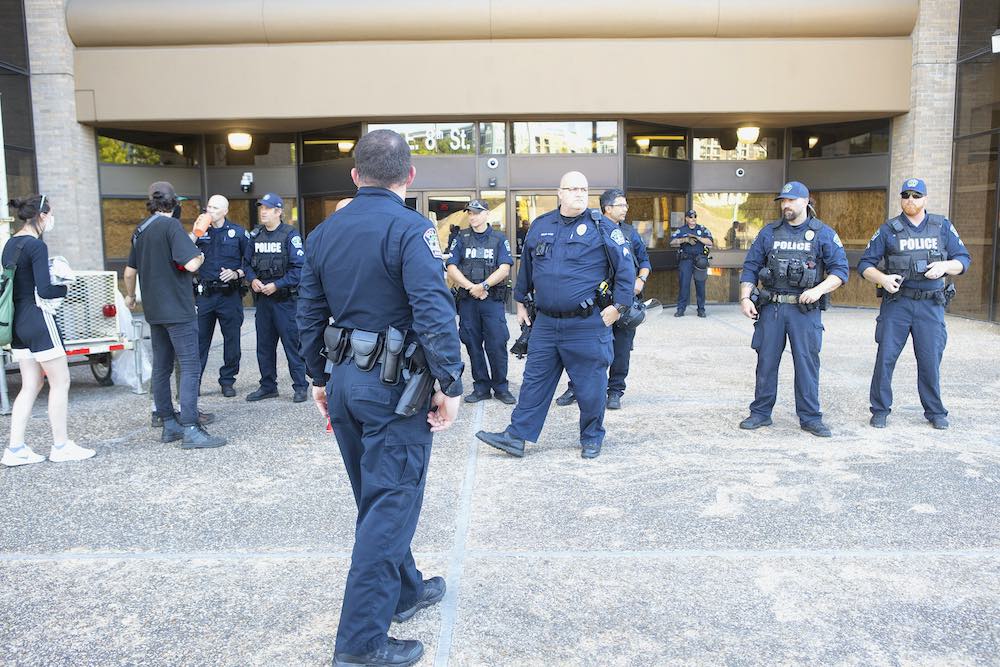Council Hears Emotional Pleas for Change in Austin Police Leadership at Emergency Hearings
CMs join community in denouncing police violence at protests
By Austin Sanders, 5:24PM, Fri. Jun. 5, 2020
“We thought he was going to die. We just didn’t know.”
With those words, Edwin Sanchez kicked off 12 hours of City Council meetings that began with emotional testimony shared by people brutalized by Austin police officers at protests over the weekend, and ended with multiple council members explicitly voicing their lack of faith in Austin Chief of Police Brian Manley.
Between sobs, Sanchez recounted the haunting hours of uncertainty he and his family endured following the hospitalization of Brad Levi Ayala, the 16-year-old Austinite an APD officer shot in the head with a lead-pellet bag. Doctors at Dell Seton Medical Center told the family that Ayala was in critical condition following the head wound. Initially, doctors thought he was shot with a rubber bullet, but after examining the wound, found it was one of the bags Manley described as “less than lethal.”
The lead-pellet bags create a larger wound, which means greater chance of infection. The impact from the munition also fractured Ayala’s skull, and doctors told the family that he suffered permanent damage to his prefrontal cortex. Ayala is having trouble regulating his emotions, Sanchez reported, and he will have to go through a potentially years-long recovery process.
Not knowing whether his young brother would survive was the hardest thing to bear, Sanchez said. “I was [at the hospital] with my mom and we prayed all night.” Ayala’s shooting was captured on video that spread across social media over the weekend. In the video, Ayala can be seen standing, alone and away from crowds, on the sloped grass embankment near I-35 and Eighth St. Then, suddenly, he drops after being hit in the head with one of the “less lethal” rounds.
Ayala attends KIPP’s Austin Brave High School, a charter that operates in town, and several callers from the school dialed in to speak to the 16-year-old’s character. One teacher, who noted that Ayala is an honors student, said that the young man was leaving his job at a sub shop and wanted to see the protests for himself. “When he was walking home that day, he called his mom and told her he’d be home safely, but first he wanted to view history,” the teacher recalled. “But he never made it home.”
In response to the shooting of Ayala, along with other incidents in which officers fired upon unarmed protesters – some of which resulted in hospitalization – Manley said he had updated the department policy regulating use of “less lethal” rounds. “The use of bean bag munitions will not be used in a crowd situation,” the Chief told Council on Thursday. “It is still an appropriate tool in many other circumstances, so it is still approved for use, but not in a crowd situation.”
The fact that Ayala was not in a crowd – let alone exhibiting any behavior that a reasonable officer might interpret as warranting the use of a lead-pellet bag fired from a .12 gauge shotgun – was cited by callers and Council Members. On Friday, Manley announced another forthcoming change to the policy, instructing officers to not shoot “less lethal” rounds at the head or neck of a subject unless in a situation where lethal force is necessary. Currently, the policy just says that officers should “not intentionally target” the head or neck.
At the Council briefing on Friday, June 5, Chief of Austin Travis County EMS Ernesto Rodriguez reported that, in all, medics responded to 53 calls for medical care at protest events from May 30 to June 2. Out of those, 29 required transport to the hospital, and 11 of those injuries were believed to be from officers firing lead-pellet bags at protesters. Some of the injuries carried the risk of brain damage, Rodriguez told Council, and many were life-threatening.
Samuel Kirsch, another protester, called in and recounted the traumatic injury he endured at the hands of Austin police officers. While running away from tear gas, Kirsch said he was shot with one of the lead-pellet bags. “I was hit in the face,” Kirsch recalled, “and if I was not wearing sunglasses, I fully believe I would be blind right now.”
The impact resulted in at least five broken bones supporting his eye, Kirsch said, and he’s not out of the woods yet. He has to undergo a risky surgery that involves an incision in his lower eyelid so surgeons can implant titanium plates that will support his eye. The surgery itself carries risk of blindness.
Following the accounts of Sanchez and Kirsch, more than 300 people called in to voice their anger, pain, and frustration over APD’s response to weekend protests. Dozens of callers told Council of demonstrating peacefully but still being subjected to a violent response from officers.
In his customary stiff, official-police-speak way, Manley offered an explanation for why such force was used on crowds in Austin: Department leaders watched events unfold across the nation – including the burning of a police precinct by protesters in MInneapolis – and received reports that some groups attending local protests were preparing for violence.
Ultimately, that violence was limited to rocks and water bottles thrown at police. “Whether or not there’s a response depends on what officers are confronted with,” Manley told Council at one point. To rocks and bottles, officers responded with chemical agents and munitions that caused brain damage and other life-altering injuries. “I have come to the conclusion that we have had some results that were not intended,” Manley said.
At this point, according to Manley, APD’s Special Investigations Unit is looking into ten incidents of potentially improper use of force. The chief also said that Travis County District Attorney Margaret Moore has expressed interest in bringing criminal charges against officers should internal investigations conclude they are warranted. As we reported earlier this week, the D.A.’s office has not secured a single indictment in a police shooting in the last five years, despite several cases being brought to a special grand jury for review.
Farah Muscadin, director of Austin’s Office of Police Oversight, reported her team had advanced for APD Internal Affairs review 159 formal complaints made against officers just this week, “That is unprecedented,” she told Council, noting that the previous Office of the Police Monitor received, on average, around 50 complaints per year for the 15 years it existed. Those 159 are just some of the hundreds of complaints OPO has received; around 250 alone came on behalf of Justin Howell, the Black 20-year-old who was hospitalized after being shot on Sunday with a lead-pellet bag.
The vast majority of Austinites who addressed Council Thursday night shared a common message: Fire Manley. A handful of callers did defend the chief and the department, but Manley, a 20-year APD veteran who earned local and national acclaim during the Austin bombings in 2018, has lost the faith of much of the community he was appointed to protect and serve.
After two days of testimony and briefings, four Council Members indicated they had also lost confidence in Manley. CM Greg Casar, often the most outspoken champion of progressive values on Council, was the first to ask Manley to resign. “In this moment we need our police department to be able to work together with our community,” Casar said. “We have to repair what is tearing at the seams … Chief, for our city to heal and make progress, I believe the honorable thing would be for you to resign as police chief.”
It was a striking moment, as elected officials began to join the growing calls from activists and community members for new leadership to transform a department that has resisted such changes for decades. Soon, three other CMs would join Casar in calling for Manley to resign. Pio Renteria, a lifelong Austinite who has witnessed firsthand the failure of many attempts to reform and improve APD’s performance, said he was “really losing confidence” in Manley. “I’d like to have a feeling we have a chief willing to implement these policies that would prevent police shooting our citizens here in Austin.”
Mayor Pro Tem Delia Garza, a former Austin firefighter, also shared her exasperation. “I know that these problems are incredibly complex and it takes more than one decision to move in a different direction,” she said. However, “I don’t know how we move past this, how we retain faith in our community after this weekend, after seeing that video …. of a 16-year-old boy just go limp. I don’t know how we move past this without a change.”
Regular Chronicle readers know that the frustrations expressed here by CMs didn’t begin this week; in his two years at the helm of APD, Manley has more than once defied the will of Council, or at least proven an uncooperative partner in progressive reforms. Though Mayor Steve Adler stopped short of calling for Manley to resign, he made explicit reference to these rifts between Council and the chief.
“We need a police force that supports and implements and shares that [progressive] Austin culture to which we aspire,” Adler told Manley. The mayor pointed to public, if diffuse, clashes between Manley and his leadership team and the Council majority that voted to decriminalize homelessness in June of 2019. After taking bold action to lift restrictions on people camping, sitting, and lying in public, CMs faced intense public backlash that could have been lessened had APD not been reticent to acknowledge that the new rules did not increase crime, or more proactive in helping the community understand what was and wasn’t allowed. Those tasks instead fell upon Council.
Then, in January, Council voted unanimously to effectively decriminalize low-level possession of marijuana cases. Manley openly defied the move to discourage enforcement of these offenses, characterized by CMs as an equity issue meant to help people of color who are disproportionately cited and arrested for these offenses despite using marijuana at roughly the same rates as white Austinites.
Council took action after prosecutors in Travis County and across Texas announced they would no longer prosecute most possession cases, after the state’s legalization of hemp – defined by the Legislature as cannabis with lower concentrations of psychoactive tetrahydrocannabinol (THC) – meant those cases would now require scarce and expensive lab testing. Council saw no point in writing tickets or making arrests on charges that would never go to court.
Manley disagreed. At a press conference the very next day after the Council vote, the chief told reporters, “Direction given to officers has been [that] we have not changed our enforcement protocols today." Possession of marijuana is still illegal under Texas law, and a City Council cannot force a police chief to stop enforcing state law, Manley argued.
But police chiefs can decide their officers should use their discretion to enforce (or not) a law – that’s what allows for “cite-and-release” policies. Since then, CMs have seen Manley’s response to the PoM vote as a form of insubordination. “[We’re] seeing time and time again efforts to reform and change things,” Garza said on Friday. “But we’re met with the chief, the very following day, saying, ‘I’m going to keep doing this because it is still the law of the state.’”
Adler, usually restrained in his criticism of other officials as he seeks common ground, took Manley to task. “When the city adopts a policy [like] on marijuana possession…we need a police force again that adopts and tries to further the policy direction that the city has taken,” Adler said. “I did not feel we had a real partner in that regard.”
Where does that leave a city and its elected leaders continually frustrated with the police chief’s inability or unwillingness to enact progressive reform? The calls to fire Manley have spread much farther than the activist circles where they began, into the wider community – but it’s not that easy.
The police chief is not one of the few employees the Council can hire and fire, though they do vote to ratify a chief’s appointment by the city manager – in this case, Spencer Cronk, who hired Manley and whose own job may be on the line if he doesn’t cut him loose, according to dozens of callers on Thursday. But a new wrinkle has emerged; city attorneys interpret the Texas Civil Service Code to say even Cronk cannot fire a public safety chief. He can only demote Manley to his previously held rank.
In Manley’s case, that would be Chief of Staff – the position currently held by Troy Gay. Cronk could reassign Manley to a role that would sideline him while new leadership reforms the department. But then who would replace Manley on an interim basis, let alone permanently? The portion of the Civil Service Code, Sec. 143.013(c) that makes clear a chief can only be demoted could create an incentive to pursue an outside hire – a new leader that does not come from a department plagued by revelations of a culture of racism and sexism that’s been allowed to fester by executives including Manley, Gay, Assistant Chief Jennifer Stephenson, and others.
Before that happens, CMs have promised immediate reform. Casar indicated he would bring items to the June 11 meeting intended to ensure protesters can demonstrate peacefully without fear of “less lethal” rounds. He also cited the policy changes in the “8 Can’t Wait” platform being advocated across the country by Campaign Zero. On the Council message board, Garza described plans for measures to achieve several long-sought goals: eliminating racial disparities in traffic stops, arrests and citations stemming from traffic stops, use-of-force incidents, and “deaths at the hands of APD officers.”
As unrest continues to roil through the streets of Austin and across America, will changes in leadership or policy be enough? Momentum continues to build for a different, once-unthinkable strategy: Spend less money on the police department and more money on social services.
Chris Harris, a justice advocate with Texas Appleseed who has pushed for such changes for years, told Council Thursday that “This violence demands not another study, or another round of training, or another piece of tech, but a fundamental restructuring of how we police. Now that we all see how broken the institution of policing is around the country, how it enables horrific violence, especially against Black people, we must recognize the limits of reform.”
“It is clear we can no longer count on policies being enforced to improve interactions with people and the police,” Harris continued. “We just have to drastically decrease those interactions.”
Read more in next week’s print issue, on stands June 11.
Got something to say on the subject? Send a letter to the editor.
A note to readers: Bold and uncensored, The Austin Chronicle has been Austin’s independent news source for over 40 years, expressing the community’s political and environmental concerns and supporting its active cultural scene. Now more than ever, we need your support to continue supplying Austin with independent, free press. If real news is important to you, please consider making a donation of $5, $10 or whatever you can afford, to help keep our journalism on stands.
June 28, 2024
June 26, 2024
City Council, Austin Police, Brian Manley, protests, police brutality, Brad Levi Ayala, Edwin Sanchez, Ernesto Rodriguez, Samuel Kirsch, Pio Renteria, Steve Adler, Delia Garza, Greg Casar









